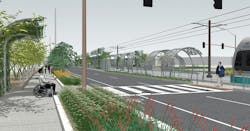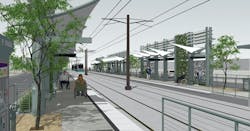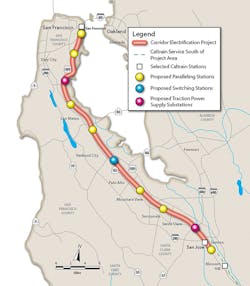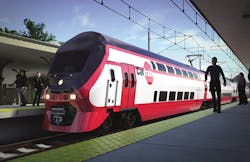The future of mobility
In the early 1900s, the personal automobile was the newest advancement in mobility. This development led to dramatic changes in our lives and in our communities. After a century of automobile improvements, freeway construction, and increasing congestion, new advances in mobility connect people in the suburbs and cities in equally dramatic, innovative ways.
Public transportation is changing to better serve communities and to operate more seamlessly as part of a diverse transportation network. This trend is demand-driven because congestion on our roadways is at an all-time high. Additionally, public demand for better service to meet mobility needs is greater than ever. Those demands include supporting the traditional suburb-to-city commute; providing mobility between city centers and retail and recreation destinations; and enhancing access through better station design and connections to other transportation modes.
According to the Federal Highway Administration’s Urban Congestion Report for October through December 2016, more than 30 of the 52 major cities surveyed reported an increase in traffic congestion compared to 2015.
The Texas A&M Transportation Institute’s (TTI) 2015 Urban Mobility Scorecard shows even more disturbing annual data about the impact of congestion:
- More than 3 billion gal of fuel are wasted;
- Commuters spend almost 7 billion additional hours in their vehicles; and
- There is a cost of $960 per commuter due to lost productivity and excess fuel consumption, which translates to $160 billion nationwide.
Congestion not only affects big cities; the scorecard data shows comparable conditions for suburbs. Congestion is four times worse than it was 30 years ago in cities with fewer than 500,000 residents.
These challenges affect everyone. Government and industry representatives must work together to address the situation head-on to deliver advanced mobility solutions. Following are three project examples that demonstrate how these advancements provide alternative solutions to congested arterials that connect suburbs and cities.
Renderings of the Phoenix Light Rail Station. Images: DWL Architects
Caltrain modernization and electrification
California’s San Francisco Bay Area and Silicon Valley are synonymous with innovative technology. This economic engine continues to drive skyrocketing population growth that, in turn, leads to more traffic congestion; San Francisco and San Jose rank in the top 10 worst traffic cities on TTI’s scorecard.
Residents and visitors in the region who want to avoid traffic rely on Caltrain passenger rail—a 77-mile route with 32 stations—to travel from San Francisco to San Jose and beyond. However, ridership demand has outgrown system capacity.
Furthermore, the majority of Caltrain’s diesel locomotive fleet is more than 30 years old and requires increased maintenance, which correlates to even greater travel delays.
Recognizing this issue, the Peninsula Corridor Joint Powers Board implemented the $1.7 billion Caltrain Modernization Program (CalMod).
This project spans 51 miles, from the 4th and King Street Station in San Francisco to the Tamien Station in San Jose. When finished in 2021, it will improve train performance, provide faster service and reduce carbon emissions. By 2040, it will:
- Reduce daily traffic congestion by 619,000 miles;
- Eliminate 176,000 metric tons of carbon dioxide emissions annually;
- Increase ridership capacity to a projected 111,000 travelers; and
- Help meet California’s emission reduction goals.
The electrification will create additional capacity within the system to permit the trains to accelerate and stop more quickly for a faster rate of pass-through. When CalMod is complete, the Caltrain rail system will see emissions improve by 97% overall.
Caltrain riders benefit greatly through its accommodation of the bicycle multimodal commuter. Daily commutes by bicycle in the city are up by record numbers, according to the 2015 Annual Bicycle Count Report released by the San Francisco Municipal Transportation Agency. Commuters make up to 82,000 bike trips per day and must find alternative and combined ways to get around.
Transportation planners recognize Caltrain’s cohort of bicycle commuters as a vocal and committed constituency, and CalMod includes a focus on enhancing this group’s riding experience. Teams work to create space through a distinctive design on Caltrain’s Electric Multiple Unit (EMU) trains. These trains could accommodate the rider and their bicycle. For instance, a six-car EMU could hold an estimated 573 passengers and 80 bicycles, helping to reduce the growing commuter footprint across the area.
CalMod is one of several initiatives San Francisco has undertaken to advance mobility options for residents and link them to nearby suburbs and cities.
A map of the Caltrain Corridor.
Phoenix light rail 50th Street Station
An August 2016 Mineta Transportation Institute report stated, “[P]ersons with disabilities can achieve a greater degree of freedom when they have full access to a variety of transit modes.”
The city of Phoenix recognized this and started construction in June 2017 on a new infill station along the existing Valley Metro Rail system to address ridership demands and mobility needs near one of the Valley of the Sun’s disability resource centers. The $23 million station will be at 50th and Washington streets and will neighbor Ability360, one of the largest disability resource centers in the southwestern U.S. It is the first capital improvement implemented by Transportation 2050, a voter-approved plan to expand Phoenix’s transportation services.
The Ability360 resource center offers services, sports and recreation facilities to promote independence for 350-500 persons with disabilities each day. Before the creation of this new station, the distance from the existing transit stations was a barrier for those who use these services.
The innovative design for accessibility at this station goes beyond what the law requires. It includes less grade variation to ease the transition between the light rail, sidewalks, and streets for wheelchairs and other personal mobility devices. With increased overhead protection and enhanced illumination, the station provides ample shade from the sun while still providing abundant lighting for passengers awaiting their train. The station design is as open as possible to allow wheelchair users greater access and ease to pass.
This infill station leverages new developments in mobility, and will provide persons with disabilities ready access to Ability360 and surrounding areas within and around Phoenix when it opens in 2019.
A Caltrain train coming into the platform. Photo: Gannett Fleming
Metrolinx GO transit regional express rail electrification
Toronto, Canada, has the country’s highest share of transit users, with approximately one out of every four commuters riding buses, streetcars or trains in 2016. Each year, more than 10 million tourists visit Toronto and approximately 68 million people ride the Metrolinx GO network. These numbers are on the rise and a new development in mobility is shaping up through Metrolinx.
Metrolinx decided to electrify its GO Transit Regional Express Rail (RER) system to fulfill its mission to develop and implement a transportation network that enhances life within the region. The planned project, a critical RER objective, will electrify five of the seven RER branch lines for more than 160 miles of railway. This will allow the trains to start, stop and move more frequently, providing considerable time savings through faster, more frequent transit options.
Metrolinx plans to comprise its train fleet of a mixture of new EMUs and electric locomotives upon project completion. The intent is to extend service to all day, with 15-minute train intervals in order to meet ridership demands. The program will fully integrate with the other routes and services in the region.
When complete, the project will enhance train performance, provide a higher frequency of stops and offer time savings. The innovative advancements applied to the GO Transit RER will enable city residents, suburban area riders and tourists to commute throughout the greater Toronto area with ease.
Electrified and modernized trains with customized accessibility for cyclists and persons with disabilities are examples of new developments in mobility that link cities to suburbs. These advances provide cleaner air, easier access, financial and time savings, and increased comfort for the rider. The demand-driven trend is to get transit riders to their destinations in a safe, efficient and sustainable way.




